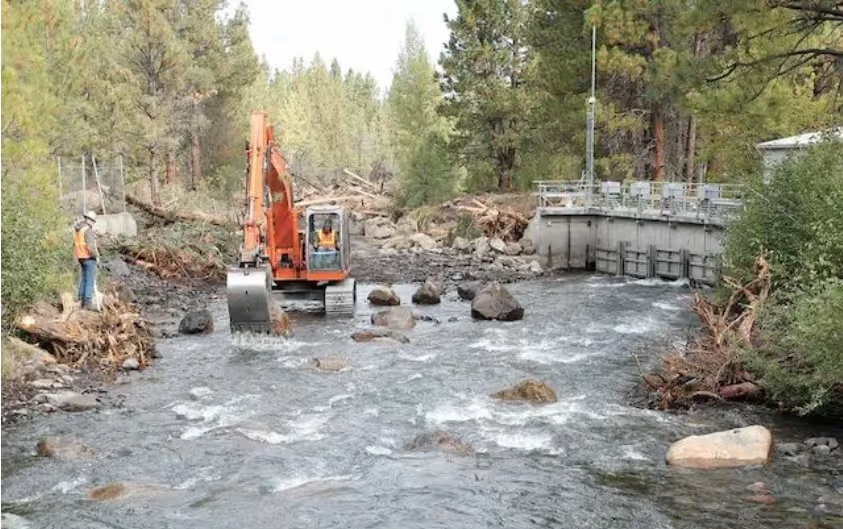Bend Bulletin: 64 miles down, one to go: Three Sisters Irrigation District almost fully piped

64 miles down, one to go: Three Sisters Irrigation District almost fully piped
By Michael Kohn
Canal piping has been a major focus for irrigation districts in Central Oregon as they scramble to complete projects, conserve water and meet federally mandated environmental obligations. One district is well ahead of the curve.
Three Sisters Irrigation District, which irrigates farms and ranches around the City of Sisters, has quietly amassed a large network of modern pipes to replace its old, inefficient canals. Recently the district announced that all but one of its 65-mile canal network has been piped.
The last mile of open canal is located on private land and is expected to be piped next year, said Marc Thalacker, a current district board member and a former district manager.
Thalacker says the district’s $50 million investment in piped infrastructure and hydropower is producing results, including low-cost energy for farmers, conserved water for streams and habitat improvements for fish and wildlife.
Environmental benefits
The main beneficiary is Whychus Creek, a tributary of the Deschutes River, which now flows year round. Resident redband trout, along with reintroduced Chinook salmon and steelhead, all benefit from having more water in the stream.
Over allocation of the stream’s water meant that the creek previously ran dry most summers, according to Jerry George, a fish biologist with the Oregon Department of Fish and Wildlife.
Historic records show that Whychus Creek could support 500 to 1,000 adult summer steelhead and several hundred Chinook salmon each year, said George, and the hope for biologists is that water conservation efforts can restore fish populations.
“Basin partners including the Deschutes River Conservancy and Three Sisters Irrigation District have been working hard over the last three decades to restore streamflows and reduce temperatures to make the stream more suitable for salmon and steelhead,” said George.
Kate Fitzpatrick, executive director of the Deschutes River Conservancy, believes piping the network was a significant feat for Three Sisters because when the work started most other districts were still fully reliant on open canals.
“They have done something extraordinary. They were one of the early adopters,” said Fitzpatrick. “Three Sisters really saw the vision of creating a piped and pressurized system from the diversion to the end user that has allowed both farmers to get the water they need while also restoring the creek.”
Cost savings
Thalacker says a fully piped network is easier to maintain than open canals, which require frequent cleaning and repair. The district’s hydroelectric component has been another benefit, saving a cumulative $800,000 annually for district patrons. Those savings allow farmers to reinvest back into the community, he says.
“Farmers continue to spend money in the local economy, buying pivots and tractors and farm buildings, and also raising higher dollar value crops,” said Thalacker, who served as district manager for 26 years before retiring last year. “Because of the pressurized water, farmers spend about $1 million to $2 million in the local economy.”
With the cost savings come another benefit — the hydropower plants produce enough energy to power around 58 homes with clean energy.
The Cloverdale Project — which runs for nearly 5 miles north of state Highway 126 — is the district’s newest stretch of pipeline. The completion of this section conserves around 140 acre-feet of water per year by preventing it from seeping into the soil.
An acre-foot is the amount of water needed to cover one acre of land to a depth of one foot. That amount of water is equal to 326,851 gallons.
All the district’s piping projects, which began in 1998, conserve around 32.5 cubic feet of water per second, said Thalacker, restoring nearly 12,000 acre-feet of water annually to Whychus Creek, benefiting the reintroduction of steelhead and other fish species to the Upper Deschutes Basin.
Pros and Cons
While the benefits are clear, George, the ODFW fish biologist, says more work needs to be done to recover fish numbers. Water temperatures in the Lower Whychus Creek remain above state standards for salmon, steelhead and trout in the irrigation season.
Matt Cyrus, a farmer in the district, adds that while it has been a great cost saving to have pressurized water that eliminates the need for pumps, the loss of canals also took away habitat for wildlife because they provided water for birds and deer.
Leakage from the canals also provided groundwater for wells. After piping occurred, many area wells had to be deepened.
“Piping has pros and cons,” said Cyrus. “It’s a huge saving … but on the other hand, the environmental side and the groundwater recharge, it’s also a big impact.”
Read more at: https://bendbulletin.com/2025/08/18/64-miles-down-one-to-go-three-sisters-irrigation-district-almost-fully-piped/

